Acura ILX Hybrid 2013 Owner's Manual
Manufacturer: ACURA, Model Year: 2013, Model line: ILX Hybrid, Model: Acura ILX Hybrid 2013Pages: 365, PDF Size: 8.63 MB
Page 311 of 365

310
Page 312 of 365
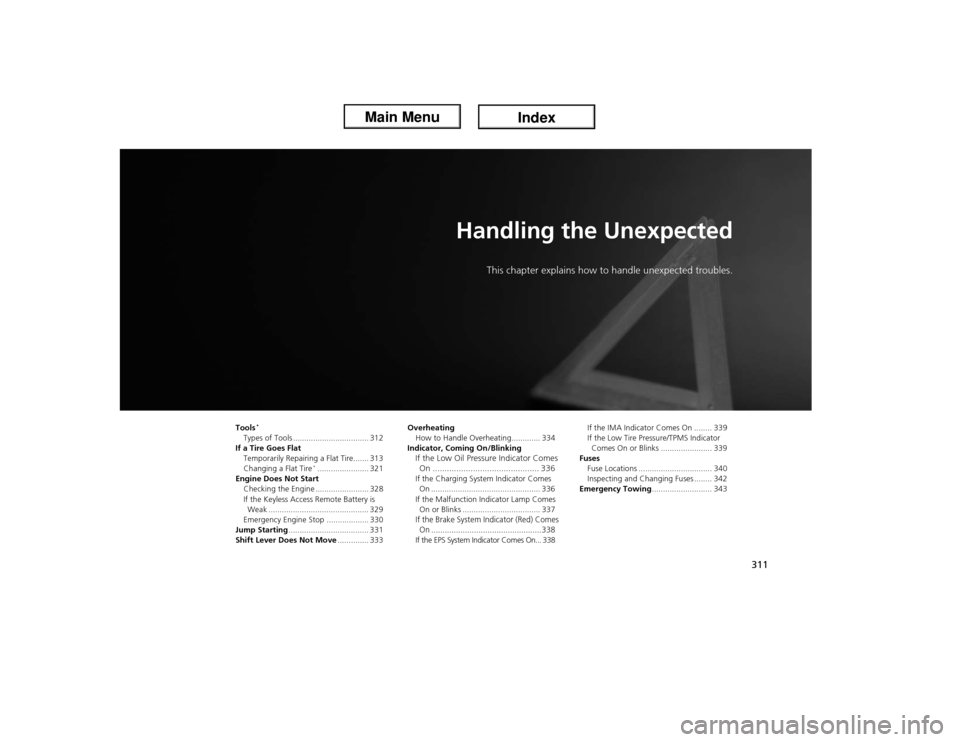
311
Handling the Unexpected
This chapter explains how to handle unexpected troubles.
Tools
*
Types of Tools .................................. 312
If a Tire Goes Flat
Temporarily Repairing a Flat Tire....... 313
Changing a Flat Tire
*....................... 321
Engine Does Not Start
Checking the Engine ........................ 328
If the Keyless Access Remote Battery is
Weak ............................................. 329
Emergency Engine Stop ................... 330
Jump Starting.................................... 331
Shift Lever Does Not Move.............. 333Overheating
How to Handle Overheating............. 334
Indicator, Coming On/Blinking
If the Low Oil Pressure Indicator Comes
On ............................................. 336If the Charging System Indicator Comes
On ................................................. 336
If the Malfunction Indicator Lamp Comes
On or Blinks ................................... 337If the Brake System Indicator (Red) Comes
On .................................................338If the EPS System Indicator Comes On... 338If the IMA Indicator Comes On ........ 339
If the Low Tire Pressure/TPMS Indicator
Comes On or Blinks ....................... 339
Fuses
Fuse Locations ................................. 340
Inspecting and Changing Fuses ........ 342
Emergency Towing........................... 343
Page 313 of 365
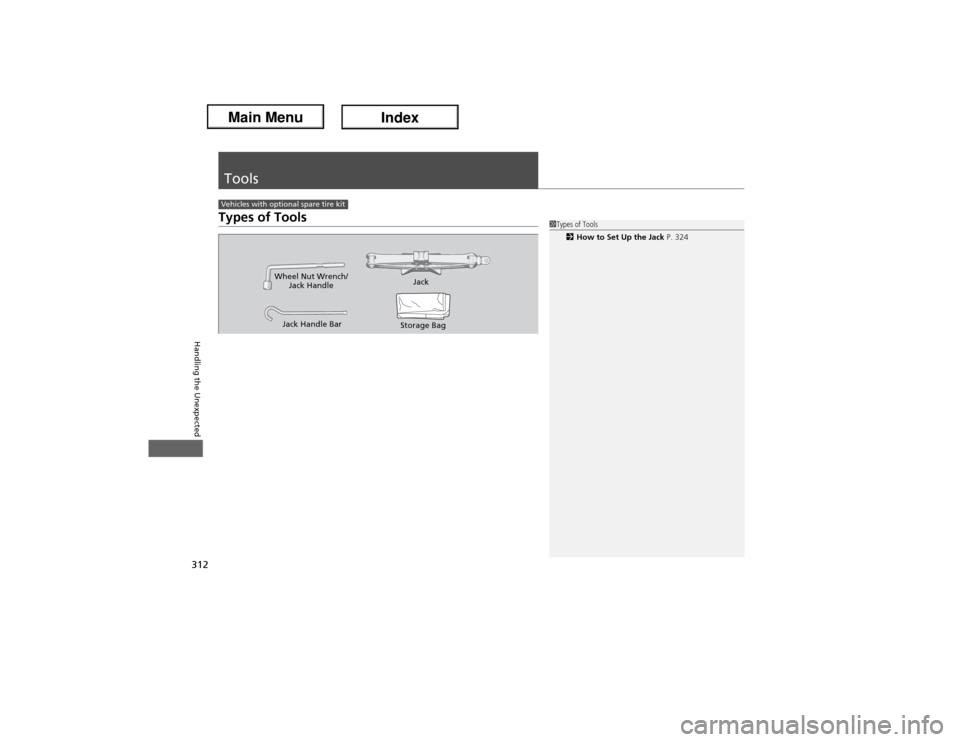
312Handling the Unexpected
ToolsTypes of ToolsVehicles with optional spare tire kit
1Types of Tools
2How to Set Up the Jack P. 324
Wheel Nut Wrench/
Jack HandleJack
Jack Handle Bar
Storage Bag
Page 314 of 365
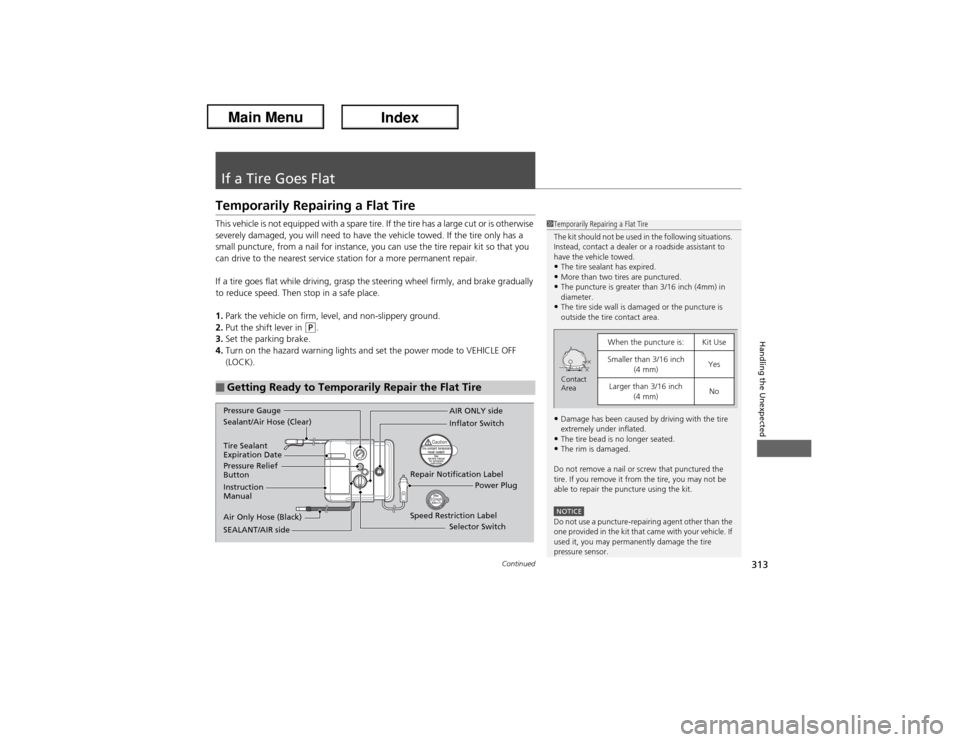
313
Continued
Handling the Unexpected
If a Tire Goes FlatTemporarily Repairing a Flat TireThis vehicle is not equipped with a spare tire. If the tire has a large cut or is otherwise
severely damaged, you will need to have the vehicle towed. If the tire only has a
small puncture, from a nail for instance, you can use the tire repair kit so that you
can drive to the nearest service station for a more permanent repair.
If a tire goes flat while driving, grasp the steering wheel firmly, and brake gradually
to reduce speed. Then stop in a safe place.
1.Park the vehicle on firm, level, and non-slippery ground.
2.Put the shift lever in
(P.
3.Set the parking brake.
4.Turn on the hazard warning lights and set the power mode to VEHICLE OFF
(LOCK).
■Getting Ready to Temporarily Repair the Flat Tire
1Temporarily Repairing a Flat Tire
The kit should not be used in the following situations.
Instead, contact a dealer or a roadside assistant to
have the vehicle towed.•The tire sealant has expired.•More than two tires are punctured.•The puncture is greater than 3/16 inch (4mm) in
diameter.•The tire side wall is damaged or the puncture is
outside the tire contact area.•Damage has been caused by driving with the tire
extremely under inflated.•The tire bead is no longer seated.•The rim is damaged.
Do not remove a nail or screw that punctured the
tire. If you remove it from the tire, you may not be
able to repair the puncture using the kit.NOTICEDo not use a puncture-repairing agent other than the
one provided in the kit that came with your vehicle. If
used it, you may permanently damage the tire
pressure sensor.
When the puncture is:
Kit Use
Smaller than 3/16 inch
(4 mm)
Yes
Larger than 3/16 inch
(4 mm)
No
Contact
Area
Instruction
Manual
Air Only Hose (Black)Speed Restriction Label Repair Notification Label Pressure Relief
ButtonInflator Switch
Selector Switch
SEALANT/AIR side Sealant/Air Hose (Clear)AIR ONLY side
Power Plug Pressure Gauge
Tire Sealant
Expiration Date
Page 315 of 365
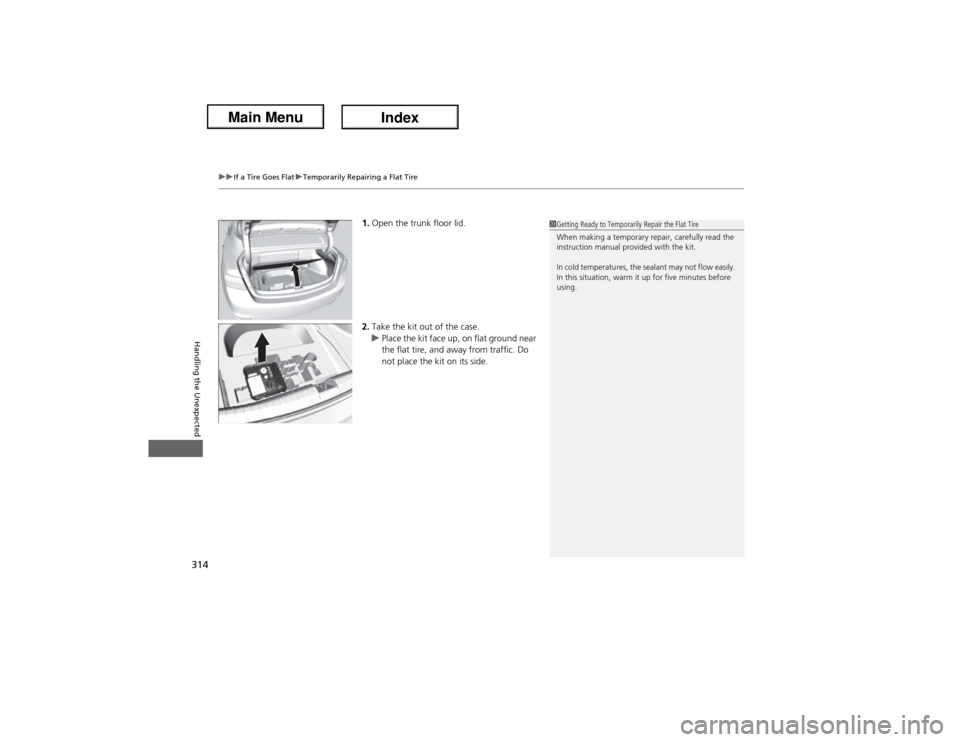
uuIf a Tire Goes FlatuTemporarily Repairing a Flat Tire
314Handling the Unexpected
1.Open the trunk floor lid.
2.Take the kit out of the case.
uPlace the kit face up, on flat ground near
the flat tire, and away from traffic. Do
not place the kit on its side.
1Getting Ready to Temporarily Repair the Flat Tire
When making a temporary repair, carefully read the
instruction manual provided with the kit.
In cold temperatures, the sealant may not flow easily.
In this situation, warm it up for five minutes before
using.
Page 316 of 365
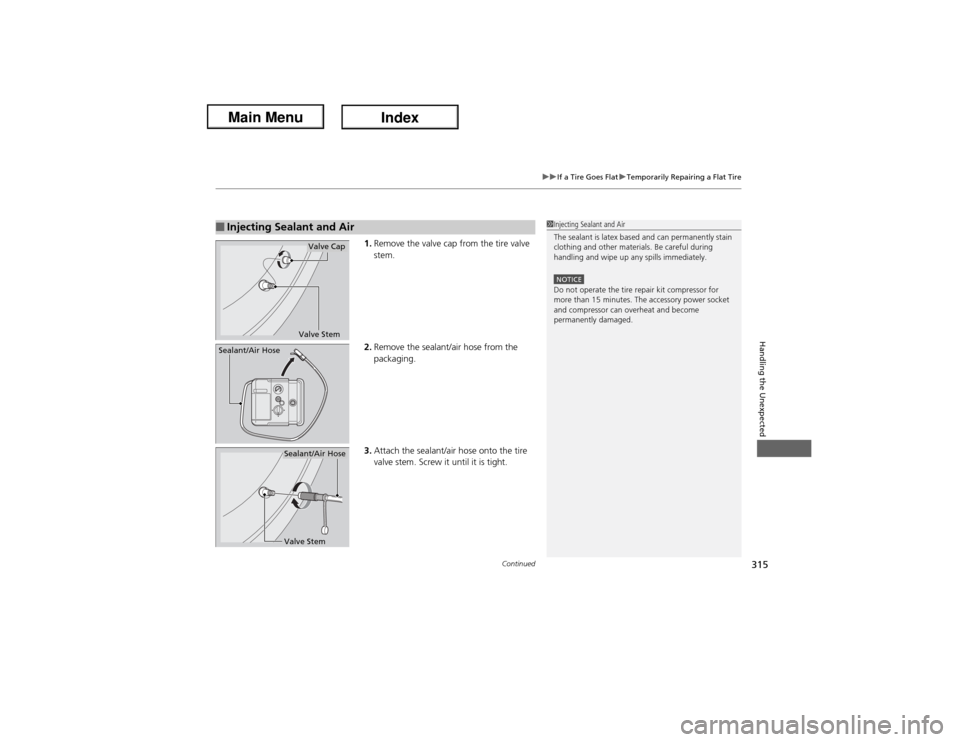
Continued
315
uuIf a Tire Goes FlatuTemporarily Repairing a Flat Tire
Handling the Unexpected
1.Remove the valve cap from the tire valve
stem.
2.Remove the sealant/air hose from the
packaging.
3.Attach the sealant/air hose onto the tire
valve stem. Screw it until it is tight.
■Injecting Sealant and Air
1Injecting Sealant and Air
The sealant is latex based and can permanently stain
clothing and other materials. Be careful during
handling and wipe up any spills immediately.NOTICEDo not operate the tire repair kit compressor for
more than 15 minutes. The accessory power socket
and compressor can overheat and become
permanently damaged.
Valve StemValve Cap
Sealant/Air Hose
Valve StemSealant/Air Hose
Page 317 of 365
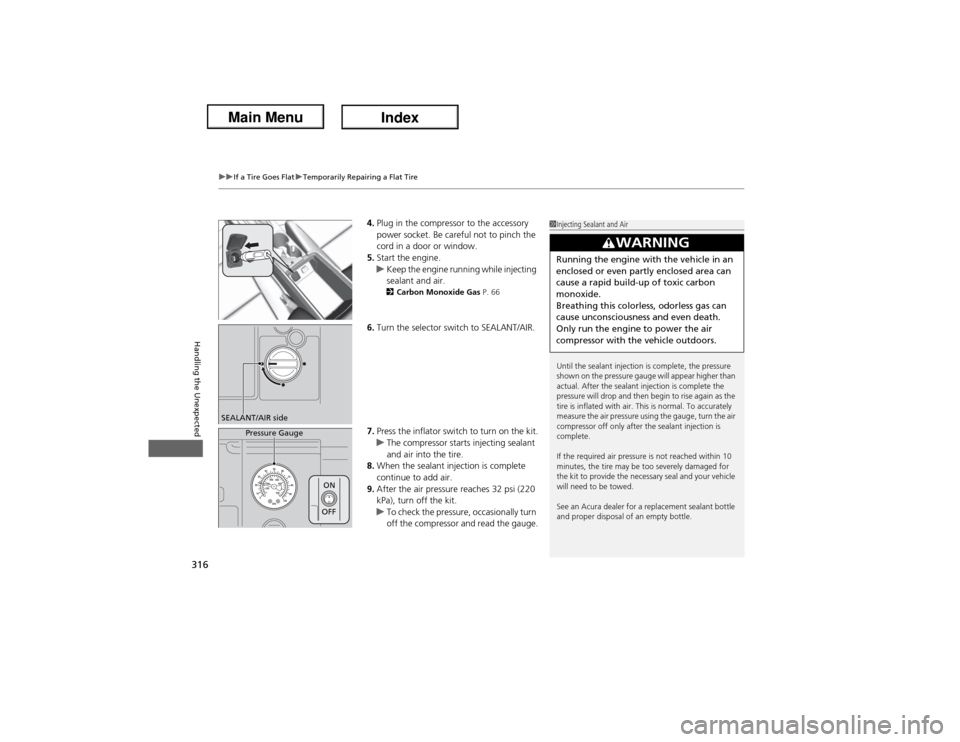
uuIf a Tire Goes FlatuTemporarily Repairing a Flat Tire
316Handling the Unexpected
4.Plug in the compressor to the accessory
power socket. Be careful not to pinch the
cord in a door or window.
5.Start the engine.
uKeep the engine running while injecting
sealant and air.
2Carbon Monoxide Gas P. 66
6.Turn the selector switch to SEALANT/AIR.
7.Press the inflator switch to turn on the kit.
uThe compressor starts injecting sealant
and air into the tire.
8.When the sealant injection is complete
continue to add air.
9.After the air pressure reaches 32 psi (220
kPa), turn off the kit.
uTo check the pressure, occasionally turn
off the compressor and read the gauge.
1Injecting Sealant and Air
Until the sealant injection is complete, the pressure
shown on the pressure gauge will appear higher than
actual. After the sealant injection is complete the
pressure will drop and then begin to rise again as the
tire is inflated with air. This is normal. To accurately
measure the air pressure using the gauge, turn the air
compressor off only after the sealant injection is
complete.
If the required air pressure is not reached within 10
minutes, the tire may be too severely damaged for
the kit to provide the necessary seal and your vehicle
will need to be towed.
See an Acura dealer for a replacement sealant bottle
and proper disposal of an empty bottle.
3
WARNING
Running the engine with the vehicle in an
enclosed or even partly enclosed area can
cause a rapid build-up of toxic carbon
monoxide.
Breathing this colorless, odorless gas can
cause unconsciousness and even death.
Only run the engine to power the air
compressor with the vehicle outdoors.
SEALANT/AIR side
Pressure Gauge
ON
OFF
Page 318 of 365
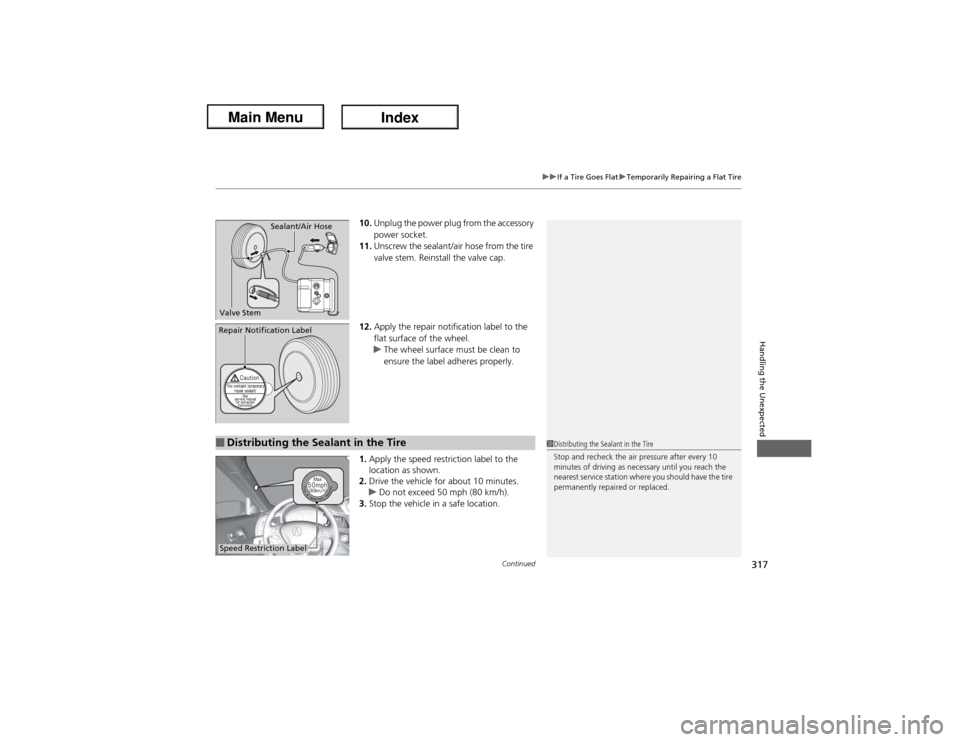
Continued
317
uuIf a Tire Goes FlatuTemporarily Repairing a Flat Tire
Handling the Unexpected
10.Unplug the power plug from the accessory
power socket.
11.Unscrew the sealant/air hose from the tire
valve stem. Reinstall the valve cap.
12.Apply the repair notification label to the
flat surface of the wheel.
uThe wheel surface must be clean to
ensure the label adheres properly.
1.Apply the speed restriction label to the
location as shown.
2.Drive the vehicle for about 10 minutes.
uDo not exceed 50 mph (80 km/h).
3.Stop the vehicle in a safe location.
Sealant/Air Hose
Valve Stem
Repair Notification Label■Distributing the Sealant in the Tire
1Distributing the Sealant in the Tire
Stop and recheck the air pressure after every 10
minutes of driving as necessary until you reach the
nearest service station where you should have the tire
permanently repaired or replaced.
Speed Restriction Label
Page 319 of 365
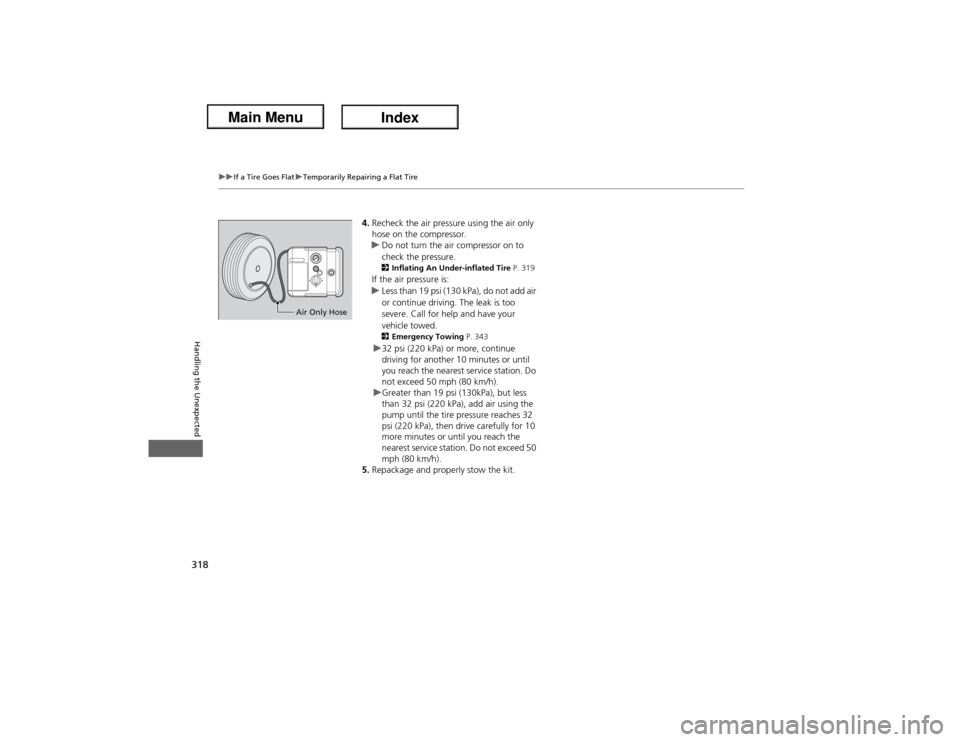
318
uuIf a Tire Goes FlatuTemporarily Repairing a Flat Tire
Handling the Unexpected
4.Recheck the air pressure using the air only
hose on the compressor.
uDo not turn the air compressor on to
check the pressure.
2Inflating An Under-inflated Tire P. 319If the air pressure is:
uLess than 19 psi (130 kPa), do not add air
or continue driving. The leak is too
severe. Call for help and have your
vehicle towed.2Emergency Towing P. 343u32 psi (220 kPa) or more, continue
driving for another 10 minutes or until
you reach the nearest service station. Do
not exceed 50 mph (80 km/h).
uGreater than 19 psi (130kPa), but less
than 32 psi (220 kPa), add air using the
pump until the tire pressure reaches 32
psi (220 kPa), then drive carefully for 10
more minutes or until you reach the
nearest service station. Do not exceed 50
mph (80 km/h).
5.Repackage and properly stow the kit.
Air Only Hose
Page 320 of 365
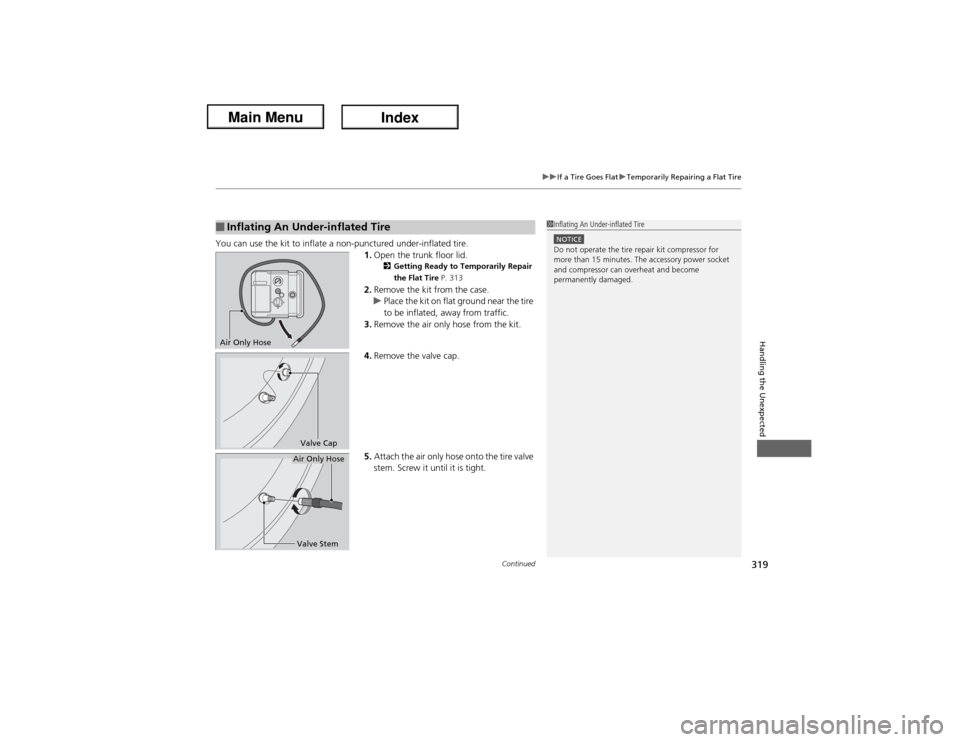
Continued
319
uuIf a Tire Goes FlatuTemporarily Repairing a Flat Tire
Handling the Unexpected
You can use the kit to inflate a non-punctured under-inflated tire.
1.Open the trunk floor lid.
2Getting Ready to Temporarily Repair
the Flat Tire P. 313
2.Remove the kit from the case.
uPlace the kit on flat ground near the tire
to be inflated, away from traffic.
3.Remove the air only hose from the kit.
4.Remove the valve cap.
5.Attach the air only hose onto the tire valve
stem. Screw it until it is tight.
■Inflating An Under-inflated Tire
1Inflating An Under-inflated TireNOTICEDo not operate the tire repair kit compressor for
more than 15 minutes. The accessory power socket
and compressor can overheat and become
permanently damaged.
Air Only Hose
Valve CapValve StemAir Only Hose